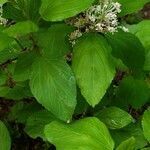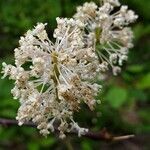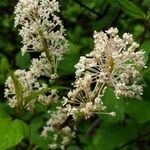Shrubs, deciduous, 1–2.5 m. Stems erect to ascending, not rooting at nodes; branchlets greenish to reddish brown, not thorn-tipped, round in cross section, flexible to ± rigid, puberulent, glabrescent. Leaves: petiole 6–25 mm; blade not aromatic, flat, ovate, ovate-elliptic, or widely elliptic, 25–100 × (17–)20–60 mm, herbaceous, not resinous, base rounded or subcordate, margins serrulate, teeth 50–100+, apex acute to rounded, abaxial surface pale green, glabrous or puberulent, especially on veins, adaxial surface green, dull, glabrate; 3-veined from base. Inflorescences axillary, paniclelike, cylindric, 5–12 cm. Flowers: sepals and petals usually white to cream, sometimes pink-tinged; nectary cream. Capsules 4–5 mm wide, weakly lobed near apex; valves smooth, usually not crested, sometimes weakly crested.
More
Shrub 1–3 m; lvs ovate-elliptic, 4–7 cm, rounded at both ends; infls borne on branches of the previous year, ascending, 8–15 cm, leafless, floriferous for half their length or more, the component umbels separated by internodes to 2 cm. Rocky hills, Keweenaw Co., Mich.; Mont. to B.C. and Calif. June.
A large shrub. It grows 1-3 m tall. The flowers are in clusters that are pyramid shape. The leaves have 2 narrow lobes at the base.
Can be grown by cuttings or seedlings. Seeds needs soaking.



